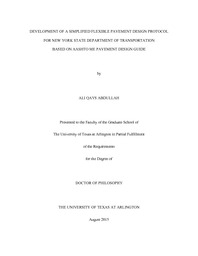
ATTENTION: The works hosted here are being migrated to a new repository that will consolidate resources, improve discoverability, and better show UTA's research impact on the global community. We will update authors as the migration progresses. Please see MavMatrix for more information.
Show simple item record
| dc.contributor.author | Abdullah, Ali Qays | en_US |
| dc.date.accessioned | 2015-12-11T23:19:55Z | |
| dc.date.available | 2015-12-11T23:19:55Z | |
| dc.date.submitted | January 2015 | en_US |
| dc.identifier.other | DISS-13080 | en_US |
| dc.identifier.uri | http://hdl.handle.net/10106/25323 | |
| dc.description.abstract | New York State Department of Transportation (NYSDOT) has used the AASHTO 1993 Design Guide for the design of new flexible pavement structures for more than three decades. The AASHTO 1993 Guide is based on the empirical relationships developed for the data collected in the AASHO Road Test in the early 1960's. A newer pavement design method, called the Mechanistic-Empirical Pavement Design Guide (MEPDG) was developed by the National Cooperative Highway Research Program to provide a more efficient and accurate design method and based on sound engineering principles. The MEPDG models have been incorporated in the AASHTOWare Pavement ME 2.1 software program that can be purchased from AASHTO. Due to the advanced principles and design capabilities of the AASHTOWare program, NYSDOT decided to implement the MEPDG and calibrate the distress models included in the software for the conditions in the state. The work conducted in this research included the local calibration of the distress models for the North East (NE) region of the United States. Design, performance and traffic data collected on Long Term Pavement Performance (LTPP) sites in the NE region of the United States were used to calibrate the distress models. First, the AASHTOWare Pavement ME 2.1 with global calibration factors was used to compare the predicted and measured distresses, values that were used for model calibration. The local bias was assessed for all distresses models except for the longitudinal cracking model; it was found the bias existed for this model even after calibration. The thermal cracking model was not calibrated because of erroneous measured data. The calibration improved the prediction accuracy for the rutting, fatigue cracking and smoothness prediction models. The AASHTOWare software was used to run design cases for combinations of traffic volume and subgrade soil stiffness (Mr) for twenty-four locations in New York State. The runs were performed for a road classified as Principal Arterial Interstate, the 90% design reliability level and 15 years design period. State-wide average traffic volume parameters and axle load spectra were used to define the traffic. The NYSDOT's Comprehensive Pavement Design Manual (CPDM) was initially used to obtain pavement design solutions. The thicknesses for the select granular subgrade materials and the asphalt layer thicknesses were varied to include several values higher and lower than the thickness recommended by CPDM. The thicknesses of asphalt surface and binder layers were kept constant; only the thickness of the asphalt base layer was changed. For each design combination, the design case with thinnest asphalt layer for which the predicted distress was less the performance criteria was selected as the design solution. The design solutions for each of the 24 locations were assembled in design tables. The comparison of the design tables showed that some variation in the design thickness for the asphalt layers exists even, with thicker asphalt layers being needed for the locations in the Upper part of the New York State. The comparison between the new design tables and the table included in the CPDM proved that the new design tables require thinner asphalt layers at low AADTT and thicker asphalt layers at high AADTT than the corresponding design in the CPDM table. For stiff subgrade soil and low AADTT, the design thicknesses are almost the same in the new design tables and in the CPDM table. | en_US |
| dc.description.sponsorship | Romanoschi, Stefan | en_US |
| dc.language.iso | en | en_US |
| dc.publisher | Civil & Environmental Engineering | en_US |
| dc.title | Development Of A Simplified Flexible Pavement Design Protocol For New York State Department Of Transportation Based On AASHTO ME Pavement Design Guide | en_US |
| dc.type | Ph.D. | en_US |
| dc.contributor.committeeChair | Romanoschi, Stefan | en_US |
| dc.degree.department | Civil & Environmental Engineering | en_US |
| dc.degree.discipline | Civil & Environmental Engineering | en_US |
| dc.degree.grantor | University of Texas at Arlington | en_US |
| dc.degree.level | doctoral | en_US |
| dc.degree.name | Ph.D. | en_US |
Files in this item
- Name:
- ABDULLAH_uta_2502D_13080.pdf
- Size:
- 2.098Mb
- Format:
- PDF
- Name:
- Electronic File.xlsx
- Size:
- 1.034Mb
- Format:
- Unknown
This item appears in the following Collection(s)
Show simple item record


